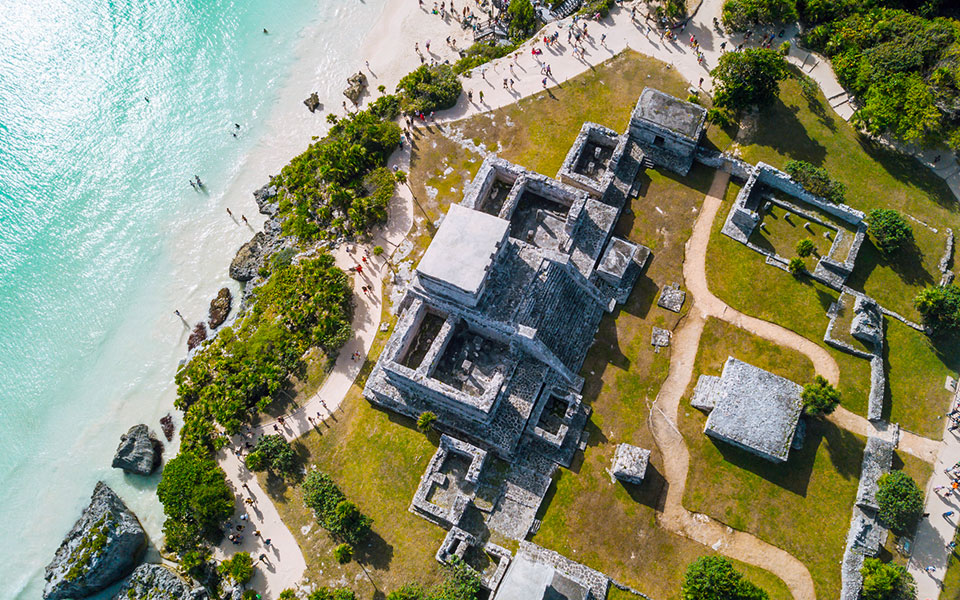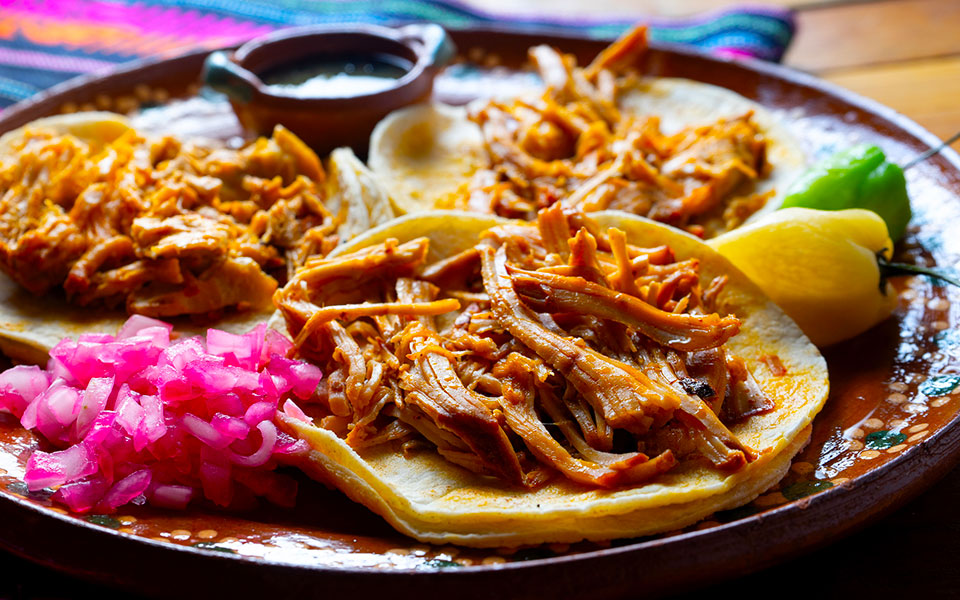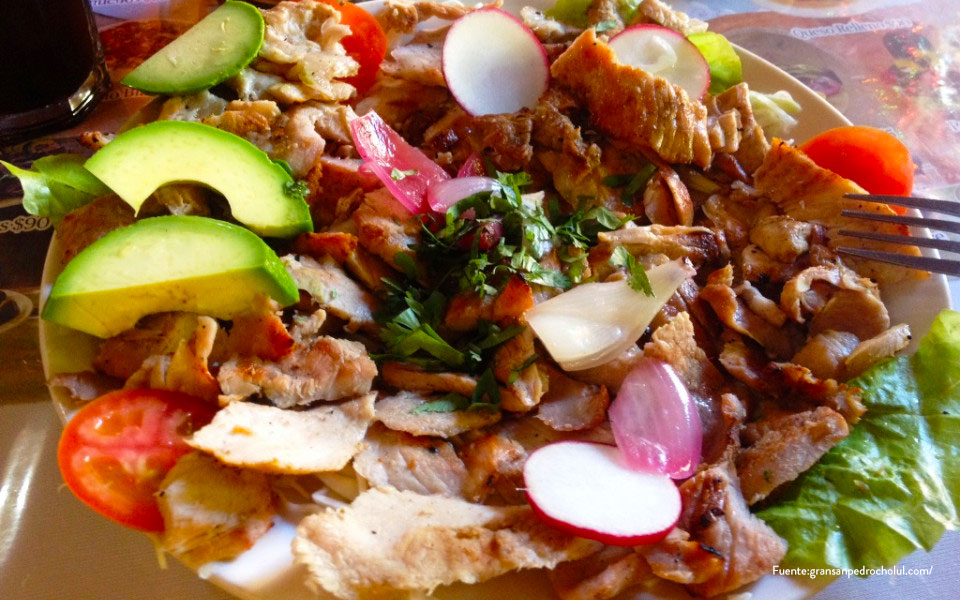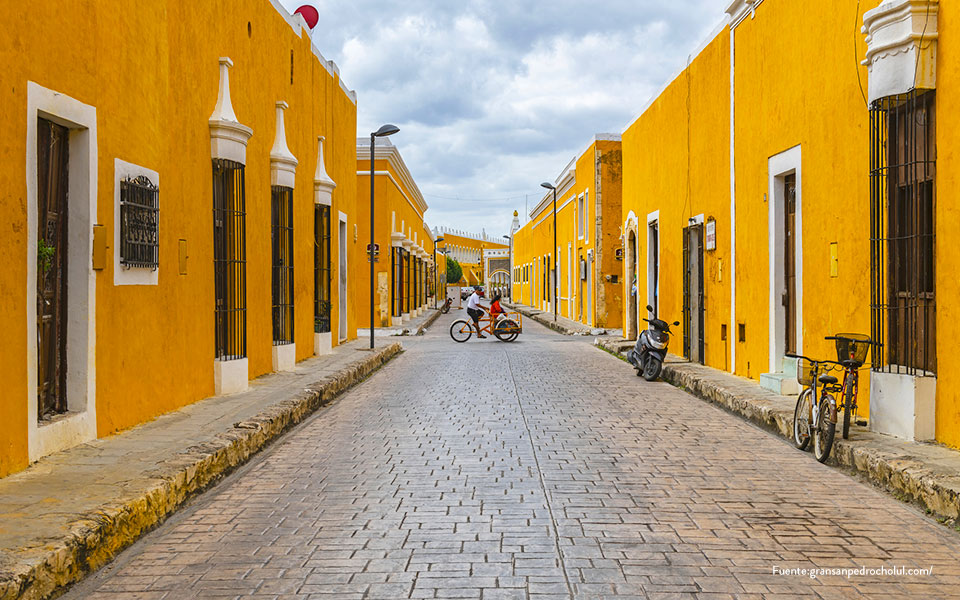

 Estimated reading time:
9 min.
Estimated reading time:
9 min.
 Published on:
July 23, 2025 | 1:36pm
Published on:
July 23, 2025 | 1:36pm
Cancún, the modern, upscale, exuberant city, is known the world over as a tourism hub on the Mexican Caribbean because of its spectacular turquoise water. However, more than just a place of extravagant beauty, Cancún is a gateway to an ancient legacy that has left a deep imprint on the region: the Mayan culture.
This comprehensive article lays out Cancún’s historic ties to the Mayan civilization. We also provide a detailed guide to the most impressive archeological sites, while spotlighting the fabulous cuisine and highly recommended tourist routes for those interested in digging a little more deeply into this fascinating culture.
Get ready for a trip that combines history, adventure, and flavors as it visits the majestic world of Quintana Roo’s indigenous peoples.
Before Cancún became a modern city in the 1970s and developed into the tourist destination it is today, this region was part of a vast territory controlled by the Mayan civilization, one of the most advanced cultures in history. In fact, the name “Cancún” comes from their language and means “snakes’ nest.”
The Yucatán Peninsula, where Cancún sits, was the region inhabited by the Mayans. To put it briefly, over thousands of years, thanks to their highly developed knowledge of mathematics, astronomy, and architecture, they created a vast network of city-states. These, over time, left an incalculable cultural and archeological legacy.
Cancún, in particular, is strategically located as a transit and trade hub. Although it wasn’t a key urban center during the Mayan era, its proximity to several prominent cities makes it a strategic jumping-off point for exploring this heritage.
Today, one can visit the site of Mayan culture and enjoy several nearby archeological sites that offer a window onto the splendor and sophistication of this ancient civilization.

This is one of the most spectacular Mayan cities, and it is located some 80.8 miles south of Cancún. The site is known for being perched up on a cliff, offering the most stunning views over the Caribbean.
During the boom years of Maya culture, Tulum was an important trading port, and due to its walled construction, it remained strong even after the Spanish Conquest.
Among the principal structures are the castle-like El Castillo, the Templo del Dios Descendente sanctuary, and Templo de los Frescos, with its carefully painted frescos.
Many of these temples and palaces are adorned with paintings and sculptures that pay homage to Mayan gods. This makes visiting Tulum like a ticket to travel through time and feel the energy that rises off its age-old walls.
Set about 87 miles west of Cancún, Cobá is an extensive archeological complex that offers travelers a truly gratifying experience. Unlike Tulum, Cobá is right in the heart of the jungle, making your visit seem like a mysterious quest.
This city was an important ceremonial and trading center, connected by a network of sacbés (white roads). But in addition to the roads, you can see the ancient ball courts, called Pitz, and Xaibé (the observatory), a monument dedicated to the seasons of the year. There are also several lakes and cenotes, unusual limestone sinkholes that form natural pools.
The area’s most noteworthy structure is Nohoch Mul pyramid. It stretches 137.8 feet high and is the Yucatán Peninsula’s highest pyramid.
Climbing to the peak of the pyramid rewards you with a sweeping view of the lush surrounding rainforest. Grab a picture to try to capture the moment or just enjoy the breathtaking reveal.
Declared a UNESCO World Heritage Site, Chichén Itzá is one of the present-day Seven Wonders of the World, making it the most famous and visited archeological site.
This city, set 124.3 miles west of Cancún, was a political, economic, and religious hub during its heyday.
Among its most iconic structures is Kukulkán temple, also known as El Castillo, or the castle. This pyramid remains in tangible evidence of the Mayas’ scientific knowledge.
Other key sites at the pyramids of Chichén Itzá include the infrastructure for the Mayan’s great ball game, the warriors’ temple, and the observatory, called El Caracol.
However, Chichén Itzá is not only remarkable for its monumental architecture, but also for the precise astronomical alignment of its location and intriguing hieroglyphic inscriptions. It has become a mandatory destination for any history or archeology lover.
Traditional Mayan Dishes and Their Influence on Local Cuisine
Mayan gastronomy is a true journey through time, opening up the experience of flavors and culinary techniques that have endured for centuries.
This culinary tradition is based on indigenous ingredients such as corn, beans, chili peppers, and cocoa beans, and ancient cooking techniques that have profoundly influenced Cancún and the Riviera Maya’s local cuisine. Favorite dishes include:
Cochinita pibil, a spicy, succulent pork dish, is one of Mayan cuisine’s most iconic dishes. This delicacy is made by marinating pork in achiote, a paste of ground annatto seeds mixed with spices and bitter orange juice.

The meat is then wrapped in banana leaves and slowly cooked in an underground oven called a pib. This gives the dish its distinctive smoky flavor and tender, juicy texture.
Traditionally, the shredded pork is served with corn tortillas, pickled red onion, and intensely spice habanero salsa. The blend of powerful, contrasting flavors plays on the palate.
A refreshing and aromatic specialty that is noteworthy for its simplicity and flavor. The soup is made by combining a clear chicken broth with lima juice, a Yucatecan lime which tastes like a floral blend of lime and grapefruit. Crispy strips of fried tortilla, chopped onion, tomato, and cilantro then round out the flavors.
The sharp bite of the lima and the cool touch of cilantro make this soup the oddly perfect companion to the region’s hot days. It is also an obvious example of how local ingredients come together to create dishes that are both nutritious and delicious.
Tamales are another staple of Mayan fare. They were an essential dish during pre-Hispanic times, and today they continue to be very popular in Cancún’s contemporary cuisine. Corn dough is wrapped around an assortment of ingredients such as beef, beans, chicken, chili peppers, and vegetables, then folded into corn husks or banana leaves and steamed.
Although the region boasts many varieties of tamales, all share the cornerstone of Mayan cuisine: corn as a main ingredient.
This is a very traditional dish that is made of pork marinated in bitter orange juice then grilled. It is dished up with grilled onion, corn tortillas, and a variety of salsas, including tomato and habanero salsa.
This dish actually reflects the influence of Spanish cuisine on Mayan gastronomy, bringing together ingredients and techniques from both worlds. Definitely worth a try.

These are a kind of pre-Hispanic enchiladas made of corn tortillas stuffed with hard-boiled egg and bathed in a sauce made of ground squash seeds and epazote leaves. They are served with red tomato-based salsa and a mildly spicy habanero salsa. The dish is rich in both flavor and history.
Papadzules are also known as bien remojado (well sauced) or alimento del amo (master’s food). They are proof of how indigenous cooking employs local ingredients creatively, producing flavors that delight the senses.
Recommended tourist routes for exploring Maya culture, leaving from Cancún
Exploring the Mayan culture more deeply should be on your list of things to do if you are planning your best vacation ever in Cancún. To help you out, here are a few recommended routes:
Start your adventure in Palenque, a World Heritage city that is sheltered under thick rainforest—guaranteed fun! Then head to Calakmul ruins, which are very close to the border with Guatemala. Live life like Indiana Jones for a while.
This route makes the perfect day trip from Cancún. First, start with a morning visit to Tulum. The peaceful morning atmosphere will let you enjoy the beauty of the place without the crowds.
In addition to exploring the ruins, you can take a dip in the crystal-clear waves at the beach that lies at the foot of the cliff.
After Tulum, move on to Cobá, some 45 minutes away by car. In Cobá you can check out the high pyramids and extensive elevated roads (sacbé). If your adventurous spirit is in high gear, rent a bike and explore the site on your own. We promise it will be a fun, vibrant experience.
This route combines a visit to one of the world’s most famous archeological sites with a more culture-focused experience in a colonial-era city. Begin your day early to get to Chichén Itzá before the crowds and mid-day heat.
After wandering Chichén Itzá, head towards Valladolid. It is a picturesque colonial-era city just a 40-minute drive away. Stroll its cobbled streets, visit the striking San Gervasio cathedral, and enjoy authentic Yucatecan gastronomy in one of the many local restaurants.
Valladolid is also known for its cenote pools, like Cenote Zací. These naturally occurring sinkholes give you the chance to cool off after a long day exploring.

If you have a little more time, consider checking out Puuc Route. This includes other, lesser known but equally impressive archeological sites, such as Kabah, Sayil, and Labná. Each of them has their own architectural and sculptural treasures.
Then there is Uxmal, one of the Maya’s most important cities in their network and renowned for its elaborate architecture.
Among its most remarkable ruins are the Adivino Pyramid —the Pyramid of the Magician—and Palacio del Gobernador—the Governor’s Palace. Here, your enthusiasm for exploring will be completely satisfied by roaming these enigmatic structures.
Exploring Mayan culture in Cancún is an enriching experience that lets you connect with the legacy of one of history’s most fascinating civilizations.
Don’t just stick to enjoying Cancún’s beaches and nightlife, head to the Maya museum in Cancún, walk in the footsteps of the ancient Mayas, and savor the traditional flavors that have lasted for centuries.
Discover this intriguing history, come and experience it for yourself!